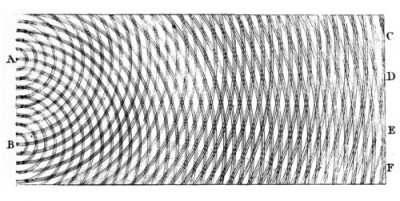Rays of light deviate from a straight course when partially cut off by any obstacle or when passing near the edges of an opening, or passing through a minute hole, and are generally accompanied by prismatic colors resulting from interference. Diffraction is a phenomenon accompanying all forms of wave motion, its effect being more marked as the wavelength increases.

Two slits (A and B) act as coherent sources of light for the observation of interference in Young's experiment. Cylindrical waves from the slits overlap and produce an interference pattern on a screen at some distance. The intensity is maximum at points where the path difference is an even number of half wavelengths, and the intensity is zero where the path difference is an odd number of half wavelengths.
Excerpted from:
1. Britannica World Language Edition of Funk & Wagnalls Standard Dictionary. 1963. Vol 1. Funk & Wagnalls Company, NY.
2. Tipler, Paul A., and Gene Mosca. 2008. Physics for Scientists and Engineers. W. H. Freeman and Company, NY. 6th Edition, p 1175.